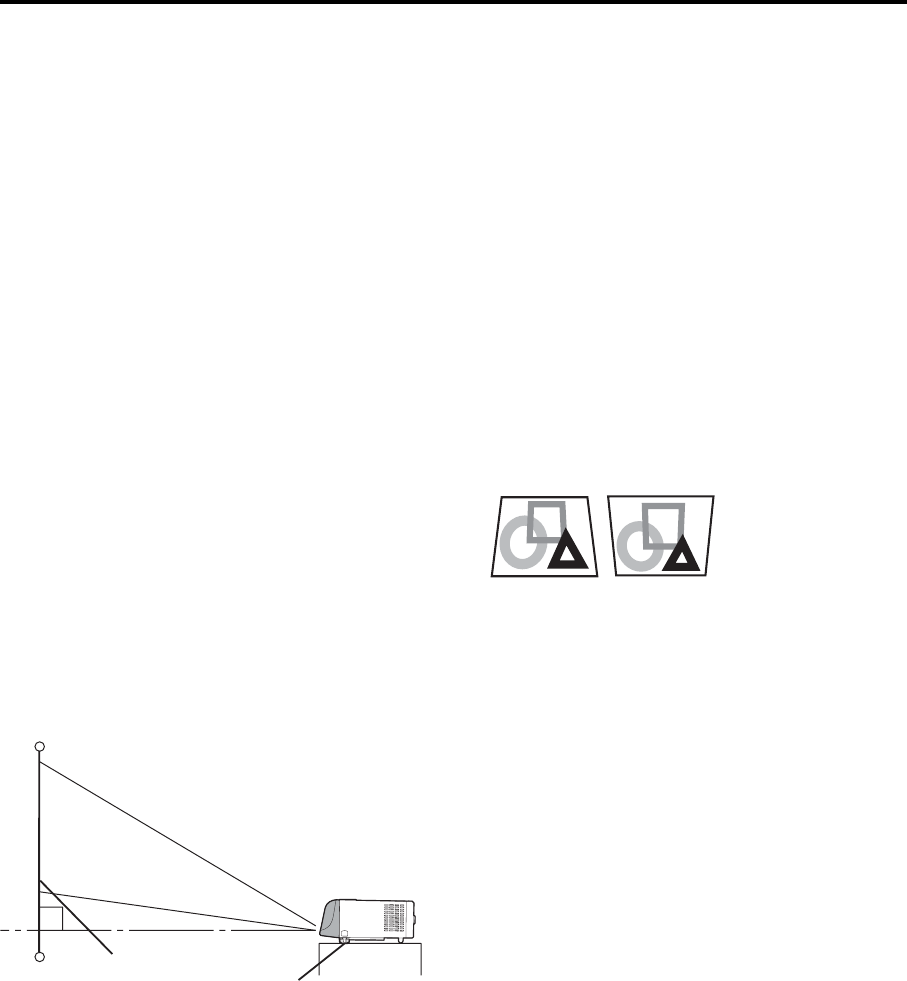
EN-12
Preparation
Preparation for projection
1. Attach the provided power cord to the projector.
2. Plug the power cord in the wall outlet.
3. Remove the lens cap.
Warning:
• Do not look into the lens directly when the projector is on.
• The lens cap is for protecting the lens. If you leave the lens cap on
the lens with the projector turned on, it may be deformed because
of heat build-up. Remove the lens cap when you turn on the
projector.
• One of power cords for the U.S., Europe and U.K. is provided
appropriately.
• This projector uses the power plug of three-pin grounding type. Do
not remove the grounding pin from the power plug. If the power
plug doesn’t fit your wall outlet, ask an electrician to change the
wall outlet.
• In case that the power cord for the U.S. is provided with this
projector, never connect this cord to any outlet or power supply
using other voltages or frequencies than rated. If you want to use a
power supply using other voltage than rated, prepare an
appropriate power cord separately.
• Use 100-240 V AC 50/60 Hz to prevent fire or electric shock.
• Do not place any objects on the power cord or do not place the
projector near heat sources to prevent damage to the power cord.
If the power cord should be damaged, contact your dealer for
replacement because it may cause fire or electric shock.
• Do not modify or alter the power cord. If the power cord is modified
or altered, it may cause fire or electric shock.
Caution:
• Plug in the power cord firmly. When unplugging, hold and pull the
power plug, not the power cord.
• Do not plug in or out the power cord with your hand wet. It may
cause electric shock.
Adjustment of the projection angle
For the best projection, project images on a flat screen installed at 90
degrees to the floor. If necessary, tilt the projector using the two
adjustment feet on the bottom of the projector.
1. Tilt up the project to the appropriate angle.
2. Press the foot adjustment buttons next to the adjustment feet,
and the adjustment feet will come out.
3. Release the buttons to lock the adjustment feet to that position.
4. Rotate the adjustment feet for fine adjustment.
After using the projector:
5. Put the adjustment feet back into the projector by pressing the
foot adjustment buttons.
Important:
• If necessary, rotate the adjustment feet (front) for fine adjustment.
• Install the screen on a flat wall at 90 degrees to the floor.
• Slanting the projector more than ±10° (right and left) or ±15° (front
and rear) may cause trouble or explosion of the lamp. You can tilt
the projector up to 7 degrees using the adjustment feet only.
• Images may not be projected in a shape of a regular rectangle or
with its aspect ratio 4:3, depending on the installation conditions of
the projector and the screen.
• To correct vertical keystone distortion, press the KEYSTONE but-
ton on the projector or the remote control to display KEYSTONE,
and adjust the image by pressing the S, T button (or VOLUME +,
- button on the remote control).
In the following cases:
• When the keystone adjustment is carried out, the adjustment
value is indicated. Note that this value doesn’t mean a projection
angle.
• The allowable range of the adjustment value in the keystone
adjustment varies depending on the installation conditions.
• When the keystone adjustment takes effect, the resolution
decreases. In addition, stripes may appear or straight lines may
bend in images with complicated patterns. They are not due to
product malfunctions.
• Noise may appear on the screen during the keystone adjustment
because of the type of the video signal being projected and the
setting values of the keystone adjustment. In such cases, set the
keystone adjustment values in the range where the image is dis-
played without noise.
• When the keystone adjustment is carried out, the image may not
be displayed correctly because of the type of input signal.
• The keystone adjustment doesn't work when no signal.
Screen
Adjustment feet
Press the T
(or -) button.
Press the S
(or +) button.


















